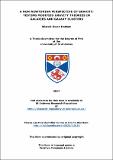Files in this item
A non-Newtonian perspective of gravity : testing modified gravity theories in galaxies and galaxy clusters
Item metadata
| dc.contributor.advisor | Zhao, Hongsheng | |
| dc.contributor.author | Hodson, Alistair | |
| dc.coverage.spatial | xxiii, 167, [7] p. | en_US |
| dc.date.accessioned | 2017-11-07T11:30:19Z | |
| dc.date.available | 2017-11-07T11:30:19Z | |
| dc.date.issued | 2017-12-07 | |
| dc.identifier.uri | https://hdl.handle.net/10023/12016 | |
| dc.description.abstract | This thesis attempts to test several frameworks of non-Newtonian gravity in the context of galaxies and galaxy clusters. The theory most extensively discussed was that of Modified Newtonian Dynamics (MOND) with Galileon gravity, Emergent Gravity (EG) and Modified Gravity (MOG) mentioned to a lesser extent. Specifically, the main focus of this thesis was to determine whether MOND and MOND-like theories were compatible with galaxy cluster data, without the need to include cold dark matter. To do this, the paradigms of Extended MOND (EMOND), Generalised MOND (GMOND) and superfluid dark matter were investigated. The theories were outlined and applied to galaxy cluster data. The main findings of this were that EMOND and GMOND had some success with explaining galaxy cluster mass profiles, without requiring an additional dark matter component. The superfluid paradigm also enjoyed some success in galaxy clusters, which was expected as it behaves in a similar manner to the standard cold dark matter paradigm in cluster environments. However, the superfluid paradigm may have issues in the very centre of galaxy clusters due to the theory predicting constant density cores, whereas the cold dark matter paradigm predicts density cores which are cuspier. The EMOND paradigm was also tested against ultra-diffuse galaxy (UDGs) data as they appear in cluster environments, where EMOND becomes important. It was found that EMOND can reproduce the inferred mass of the UDGs, assuming they lie on the fundamental manifold (FM). The validity of the assumptions used to model the UDGs are discussed in the text. A two-body problem was also conducted in the Galileon gravity framework. The amount of additional gravitational force, compared to Newtonian was determined for a small galaxy at the edge of a galaxy cluster. | en_US |
| dc.language.iso | en | en_US |
| dc.publisher | University of St Andrews | |
| dc.relation | Generalizing MOND to explain the missing mass in galaxy clusters - Alistair Hodson & Hongsheng Zhao - Accepted to Astronomy & Astrophyisics Journal | en_US |
| dc.relation | Are Over-massive Haloes of Ultra Diffuse Galaxies Consistent with Extended MOND? - Alistair Hodson & Hongsheng Zhao - Accepted to Astronomy & Astrophyisics Journal | en_US |
| dc.relation | Galaxy Clusters in the Context of Superfluid Dark Matter - Alistair Hodson, Hongsheng Zhao, Justin Khoury & Benoit Famaey - Accepted to Astronomy & Astrophyisics Journal | en_US |
| dc.relation | Galaxy Cluster A1689 in Modified MOND, MOG and Emergent Gravity - Alistair Hodson & Hongsheng Zhao - Not Yet accepted | en_US |
| dc.rights | Attribution-NonCommercial-NoDerivatives 4.0 International | * |
| dc.rights.uri | http://creativecommons.org/licenses/by-nc-nd/4.0/ | * |
| dc.subject | Galaxy dynamics | en_US |
| dc.subject | Modified gravity | en_US |
| dc.subject | Galaxy clusters | en_US |
| dc.subject.lcc | QB981.H73 | |
| dc.subject.lcsh | Cosmology--Mathematical models | en |
| dc.subject.lcsh | Gravitation | en |
| dc.subject.lcsh | Galaxies | en |
| dc.subject.lcsh | Galaxies--Clusters | en |
| dc.title | A non-Newtonian perspective of gravity : testing modified gravity theories in galaxies and galaxy clusters | en_US |
| dc.type | Thesis | en_US |
| dc.contributor.sponsor | Science and Technology Facilities Council (STFC) | en_US |
| dc.type.qualificationlevel | Doctoral | en_US |
| dc.type.qualificationname | PhD Doctor of Philosophy | en_US |
| dc.publisher.institution | The University of St Andrews | en_US |
The following licence files are associated with this item:
This item appears in the following Collection(s)
Except where otherwise noted within the work, this item's licence for re-use is described as Attribution-NonCommercial-NoDerivatives 4.0 International
Items in the St Andrews Research Repository are protected by copyright, with all rights reserved, unless otherwise indicated.


